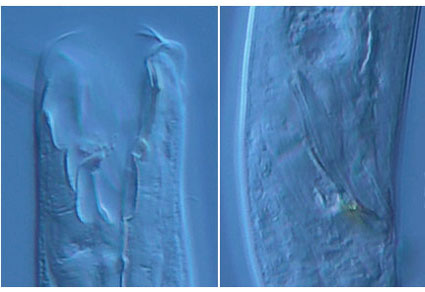Abstract
Two new free-living nematode species, Ingenia major sp. nov. and Linhystera filiformis sp. nov., are described from the Yellow China Sea. Ingenia major sp. nov. is characterized by a large body size, six outer labial setae articulated, buccal cavity barrel-shaped with three teeth, amphidial fovea small and unispiral, spicules thin and almost straight with a pair of ventro-laterally directed teeth hooked distally, gubernaculum kidney-shaped with triangular cuticularized projection, tail conical and with swollen-terminus. Relationship between Ingenia and Bathylaimus is discussed, and Ingenia communis Gagarin & Thanh, 2007 is transferred as Bathylaimus communis comb. n. based on the buccal cavity shape. Linhystera filiformis sp. nov. is characterized by filiform body, buccal cavity minute and slit-like, six outer labial setae and four cephalic setae in the same circle and with the same length, amphidial fovea relatively small and circular, spicules short and sickle-shaped, gubernaculum boat-shaped, tail filiform with three terminal setae. An identification key for valid species of Linhystera is also given.
References
- Chitwood, B.G. (1951) North American nematodes. The Texas Journal of Science, 4, 617–672.
- Cobb, N.A. (1894) Tricoma and other nematode genera. The proceedings of the Linnean Society of New South Wales, 8, 389–421.
- Filipjev, I.N. (1918) Free-living marine nematodes of the Sevastopol area. Transactions of the Zoological Laboratory and the Sevastopol Biological Station of the Russian Academy of Sciences Series, 2, 1–203.
- Filipjev, I.N. (1929) Classification of freeliving Nematoda and relations to parasitic forms. Journal of Parasitology, 15, 281–282.
- Fonseca, G. & Bezerra, T.N. (2014) Order Monhysterida Filipjev, 1929. In: Schmidt-Rhaesa, A. (Ed.), Gastrotricha, Cycloneuralia, Gnathifera. Vol. 2. Nematoda. Handbook of Zoology. De Gruyter, Berlin, pp. 435–465. https://doi.org/10.1515/9783110274257.435
- Gagarin, V.G. & Nguyen, V.T. (2007) Ingenia communis sp. n., Adoncholaimus longispiculatus sp. n. and Viscosia sedata sp. n. (Nematoda: Enoplida) from Mekong River Delta, Vietnam. International Journal of Nematology, 17 (2), 205–212.
- Gerlach, S.A. (1957) Die Nematodenfauna des Sandstrandes an der Küste von Mittelbrasilien (Brasilianische Meerse-Nematoden IV). Mitteilungen Aus Dem Zoologischen Museum in Berlin, 33 (2), 411–459. https://doi.org/10.1002/mmnz.19570330206
- Juario, J.V. (1974) Neue freilebende Nematoden aus dem Sublitoral der Deutschen Bucht. Veröffentlichungen Des Instituts für Meeresforschung in Bremerhaven, 14, 275–303.
- Leduc, D. & Zhao, Z.Q. (2023) The Marine Biota of Aotearoa New Zealand. Ngâ toke o Parumoana: Common free-living Nematoda of Pâuatahanui Inlet, Te-Awarua-o-Porirua Harbour, Wellington. NIWA Biodiversity Memoir, 135, 1–212.
- Lorenzen, S. (1977) Revision der Xyalidae (freilebende Nematoden) auf der Grundlage einer kritischen Analyse von 56 Arten aus Nord- und Ostsee. Veröffentlichungen Des Instituts für Meeresforschung in Bremerhaven, 16, 197–261.
- McIntyre, A.D. & Warwick, R.M. (1984) Meiofauna techniques. In: Holme, N.A. & McIntyre, A.D. (Eds.), Methods for the Study of Marine Benthos. Blackwell Scientific Publications, Oxford, pp. 217–244.
- Pastor de Ward, C.T. (1985) Nematodes marinos de la ria deseado (Monhysteroidea, Xyalidae) Santa Cruz Argentina II. Physis, Buenos Aires, 43, 113–130.
- Pavlyuk, O.N., Trebukhova, Y.A., Shcherbakov, I.A., Tarasova, T.S., Lutaenko, K.A., Chen, L.L., Song, B., Li, X.J. & Li, B.Q. (2022) Taxonomic Composition and Spatial Distribution of Meiofauna Community from a Sandy Intertidal Zone in Sishili Bay, Yellow Sea Coast (Northern China). Journal of Ocean University of China (Oceanic and Coastal Sea Research), 21, 1389–1401. https://doi.org/10.1007/s11802-022-5048-5
- Smol, N., Muthumbi, A. & Sharma, J. (2014) Order Enoplida. In: Schmidt-Rhaesa, A. (Ed.), Gastrotricha, Cycloneuralia, Gnathifera. Vol. 2. Nematoda. Handbook of Zoology. De Gruyter, Berlin, pp. 193–249. https://doi.org/10.1515/9783110274257.193
- Yu, T.T., Huang, Y. & Xu, K.D. (2014) Two new nematode species, Linhystera breviapophysis and L. longiapophysis (Xyalidae, Nematoda), from the East China Sea. Journal of the Marine Biological Association of the United Kingdom, 94 (3), 515–520. https: //doi.org/10.1017/S0025315413001811


